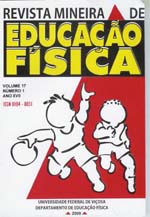ANÁLISE DO DESEMPENHO COMPETITIVO NA PISTA DE PENTATLO MILITAR POR MEIO DA BIOMECÂNICA
Palavras-chave:
pentatlo militar, pista de obstáculos, tempo parcial, correlaçãoResumo
O conhecimento das características competitivas de uma determinada modalidade esportiva é de fundamental importância para direcionar o processo de treinamento. O objetivo do presente estudo foi investigar as variáveis cinemáticas relacionadas ao desempenho na Pista de Obstáculos do Pentatlo Militar (PPM). A amostra consistiu em sete atletas, divididos em dois grupos: Grupo Equipe do Brasil (Gp_Brasil) – seis atletas integrantes da equipe do Brasil de Pentatlo Militar; e Grupo Recordista (Gp_Recorde) – atleta recordista mundial da PPM. Por meio da cinemetria, foram mensurados dois componentes: o tempo de transposição de obstáculos (TTO) e o tempo de corrida limpa (TCL). A partir dessas definições, foi possível trabalhar com a variável “tempo” de cada um dos componentes: média TTO, média TCL e tempo total oficial da competição de cada atleta (TT). Considerando os trechos de TCL e TTO e comparando-os entre Gp_Brasil (TCL=4.18s; TTO=2.886s) e Gp_Recorde (TCL=3.366s; TTO=2.784s), o resultado médio encontrado dos tempos obtidos indicou que não houve diferença significativa entre os grupos. Embora não se evidenciasse diferença significativa entre os grupos, verificouse que o GR foi 19,47% mais rápido que o GB no que se refere ao TCL. Os resultados do presente estudo sugerem que o TTO e TCL apresentam alta correlação com o resultado do TT da PPM, porém somente o TCL mostrou correlação significativa. Desse modo, fica evidente a necessidade de se enfatizar o treinamento de corrida, técnica de corrida, velocidade de reação e tempo de reação, a fim de aperfeiçoar o TCL e, assim, melhorar o desempenho na modalidade.
Downloads
Referências
AMADIO, A. C.; COSTA, P. H. L.; SACCO, I. C. N.; SERRÃO, J. C.; ARAUJO, R. C.; MOCHIZUKI, L.; DUARTE, M. Introdução à análise do movimento humano: descrição e aplicação dos métodos biomecânicos de medição. Rev. Bras. Fisiot., v. 3, n. 2, p. 41-45, 1999.
AMADIO, A. C.; SERRÃO, J. C. Contextualização da biomecânica para a investigação do movimento: fundamentos, métodos e aplicações para análise da técnica esportiva. Rev. Bras. Educ. Fís. Esp., São Paulo, v. 21, p. 61-85, 2007.
ARELLANO, R.; BROWN, P.; CAPPAERT, J.; NELSON, R. C. Analysis of 50 m, 100 m and 200 m freestyle swimmers at the 1992 Olympic Games. J. Appl. Biomech., v. 10. n. 2, p. 189-199, 1994.
ION, L. Optimizing military-marine student's performance for the obstacle course test. Ovidius University Annals, Series Physical Education and Sport. Science, Movement and Health, v. 9, n. 2, p. 278-282, 2009.
JÜRINÄE, J.; HALJASTE, K.; CICCHELLA, A.; LÄTT, E.; PURGE, P.; LEPPIK, A.; JÜRIMÄE, T. Analysis of swimming performance from physical, physiological, and biomechanical parameters in young swimmers. Pediatric Exercise Science, v. 19, p. 70-81, 2007.
MARINHO, P. C. Análise da atividade competitiva dos nadadores brasileiros pertencentes a diferentes categorias. 2003. Tese (Doutorado em Ciências do Esporte) – UNICAMP, 2003.
STEFANI. R. T. The relative power output and relative lean body mass of world and olympic male and female champions with implications for gender equity. J. Sports Sci., v. 24, n. 12, p. 1329-39, 2006.
THOMPSON, K. G. A comparison of selected kinematic variables between races in
national to elite male 200 m breaststroke swimmers. The Journal of Swimming Research, s. l, v. 2, p. 6-10, 2004.
WILLIAMS, S. J.; KENDALL, L. R. A profile of sports science research (1983-2003). Journal of Science and Medicine in Sport, v. 10, n. 4, p. 193-200, 2007.
WINTER, D. A. Biomechanics and motor control of human movement. New Jersey: Jonh Wiley & Sons, 2009.
Downloads
Publicado
Como Citar
Edição
Seção
Licença
Os artigos submetidos e publicados são de inteira responsabilidade de seus autores, não refletindo necessariamente a opinião do Comitê Editorial. A revista se reserva o direito de efetuar, nos originais, alterações de ordem normativa, ortográfica e gramatical, com vistas a manter o padrão culto da língua, respeitando, porém, o estilo dos autores. O manuscrito submetido deve ser original, não podendo ter sido publicado em qualquer outro veículo de informação científica, e nem submetido para publicação em outra revista científica. Os trabalhos publicados passam a ser propriedade da revista Mineira de Educação Física, ficando sua reimpressão total ou parcial de acordo com a licença Creative Commons Attibution 4.0. Deve ser consignada a fonte de publicação original. Os originais não serão devolvidos aos autores. As opiniões emitidas pelos autores dos artigos são de sua exclusiva responsabilidade.





 Esta obra está licenciada com uma Licença
Esta obra está licenciada com uma Licença 